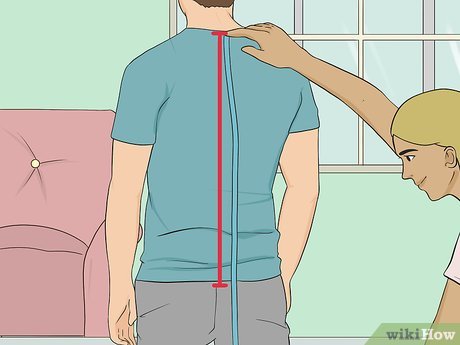How to Measure Torso Length: A Comprehensive Guide
Measuring your torso length is an important aspect of achieving the right fit for clothing, backpacks, and other gear. Whether you’re shopping for a new shirt, determining the correct size for a backpack, or simply curious about your body proportions, understanding how to measure your torso accurately can help you make informed decisions. This article provides a detailed guide on how to measure your torso length, the significance of this measurement, and tips for achieving accurate results.
Understanding Torso Length
The term “torso” refers to the central part of the human body, excluding the head and limbs. It encompasses several anatomical structures, including the ribcage, abdomen, and back. Measuring torso length involves determining the distance from a specific point on your body (usually at the base of the neck) down to another point (typically at the waist or iliac crest).
Why Measure Torso Length?
There are several reasons why measuring your torso length is important:
- Clothing Fit: Knowing your torso length helps you select clothing that fits well and flatters your body shape. This is especially important for fitted garments like dresses, suits, and tailored shirts.
- Backpack Sizing: For outdoor enthusiasts or students, measuring torso length is critical for selecting a properly fitting backpack. A well-fitted backpack distributes weight evenly and reduces strain on your back.
- Body Proportions: Understanding your torso length in relation to your overall height can provide insights into your body proportions, which can be beneficial for fashion choices and personal styling.
- Health Assessments: In some cases, torso length measurements can be used in health assessments to evaluate body composition and distribution of fat.
How to Measure Torso Length: Step-by-Step Guide
Measuring your torso length can be done easily with a flexible measuring tape. Here’s a step-by-step guide:
Materials Needed
- A flexible measuring tape (preferably cloth or soft plastic)
- A mirror (optional)
- A friend to assist you (optional but helpful)
Step 1: Identify Measurement Points
- Top of Your Torso: Locate the bony bump at the base of your neck (the C7 vertebra). To find this point, tilt your head slightly forward; the bump will become more prominent.
- Bottom of Your Torso: Find the iliac crest by placing your hands on your hips and sliding them up until you feel the ridge of bone at the top of your hip bones. This will be where you stop measuring.
Step 2: Position Yourself
- Stand up straight with your shoulders relaxed.
- Ensure that you are wearing form-fitting clothing or no clothing at all for the most accurate measurement.
Step 3: Measure Your Torso Length
- Start Measuring: Place one end of the measuring tape at the C7 vertebra (the top of your torso).
- Follow Your Spine: Run the tape down along the center of your spine while following its natural curves.
- Stop at Iliac Crest: Measure down to where you feel the iliac crest—the top edge of your hip bones.
Step 4: Record Your Measurement
- Take note of the measurement in inches or centimeters.
- If possible, measure twice to ensure accuracy.
Tips for Accurate Measurements
- Use a Flexible Tape Measure: A cloth or soft plastic tape measure is ideal as it can easily conform to body contours.
- Stand Straight: Maintain good posture while measuring; this ensures that you get an accurate reading without any slouching.
- Have Someone Assist You: If possible, have a friend help you hold the tape measure for better accuracy.
- Measure Twice: To ensure precision, take two measurements and use the average if they differ significantly.
- Wear Appropriate Clothing: For best results, wear form-fitting clothing when taking measurements.
Understanding Your Torso Length
Once you’ve measured your torso length, you may want to understand what it means in relation to body proportions:
- Short Torso: Typically characterized by a shorter distance between the base of the neck and iliac crest compared to overall height.
- Long Torso: Defined by a longer distance between these two points relative to height.
These proportions can influence how clothing fits and how styles are chosen.
Average Torso Length by Height
Research indicates that torso length can vary based on overall height but does not differ significantly between genders. A common method to estimate average torso length is to multiply height by approximately 0.27.
| Height (inches) | Estimated Torso Length (inches) |
|---|---|
| 5’0″ | 13.5 |
| 5’4″ | 14.5 |
| 5’8″ | 15.5 |
| 6’0″ | 16.5 |
| 6’4″ | 17.5 |
Common Applications of Torso Length Measurement
- Clothing Design: Designers often use torso measurements to create patterns that fit various body types.
- Sports Equipment Fitting: Athletes may need specific equipment sizes based on their torso lengths for optimal performance.
- Health Monitoring: Health professionals may assess body proportions using torso measurements as part of physical examinations.
Conclusion
Measuring your torso length is a straightforward process that can significantly impact how clothing fits and how comfortable you feel in various gear like backpacks or sports equipment. By following this guide and understanding what affects torso length measurements, you can ensure that you make informed choices whether shopping for clothes or assessing your body proportions.
Frequently Asked Questions (FAQ)
1. How do I know if I have a long or short torso?
You can determine this by comparing your torso measurement with average estimates based on height or by assessing how clothing fits relative to others with similar heights.
2. What should I wear while measuring my torso?
It’s best to wear form-fitting clothing or no clothing at all to ensure accurate measurements without interference from loose fabric.
3. Can I measure my torso length alone?
Yes, but having someone assist you can make it easier and more accurate since they can help hold the tape measure steady.
4. Is there an ideal torso length for certain activities?
Different activities may require different fits; for example, shorter torsos might find certain styles more comfortable in swimsuits or athletic wear due to their proportions.
5. Where can I find more information about body measurements?
You can refer to Wikipedia on Body Measurements for additional insights into human anatomy and measurement techniques.By understanding how to accurately measure your torso length and its implications, you will be better equipped to choose clothing and gear that fits well and enhances comfort in various activities.



